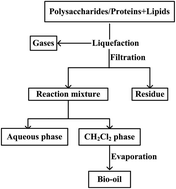The role of polysaccharides and proteins in bio-oil production during the hydrothermal liquefaction of algae species
Abstract
In order to understand the effects of the major algal components-carbohydrates and proteins on the hydrothermal liquefaction (HTL) process of algae, the HTL of polysaccharides or proteins with lipids was performed at 220, 260, 300 °C, respectively. Bio-oil yields and qualities were investigated and compared with the individual liquefaction of the major algal components. Results show that the presence of polysaccharides or proteins has little effect on bio-oil yield but increased the HHV and significantly changed the boiling point distribution as compared with the HTL of lipids. The compositions of bio-oils from the HTL of binary mixtures were similar to that from the HTL of lipids. Heavy components in bio-oil were increased in the presence of polysaccharides or proteins, which was mainly caused by the hydrolysis product of polysaccharides/proteins being easily polymerized during the HTL process, forming macromolecular compounds into bio-oil.



 Please wait while we load your content...
Please wait while we load your content...